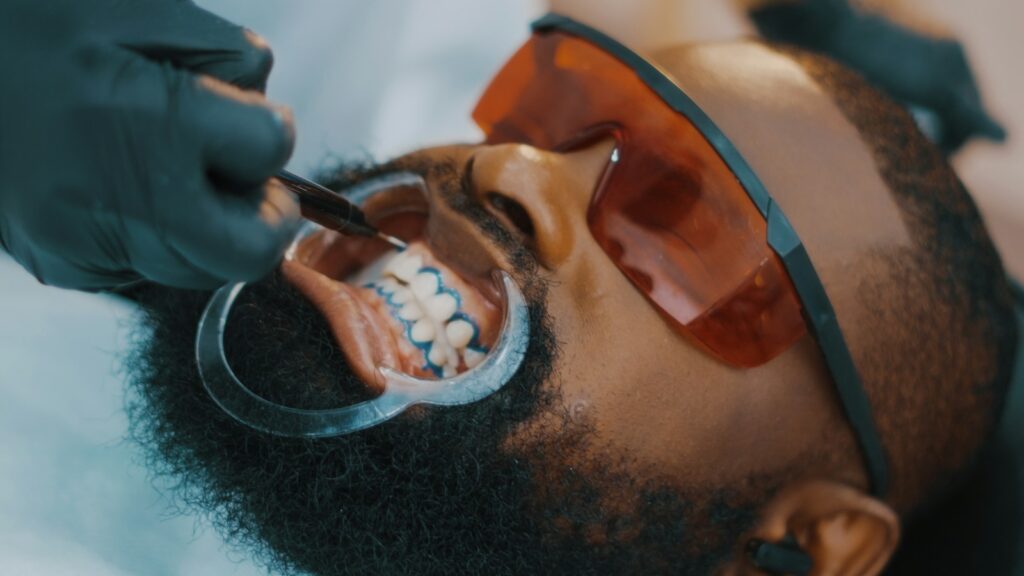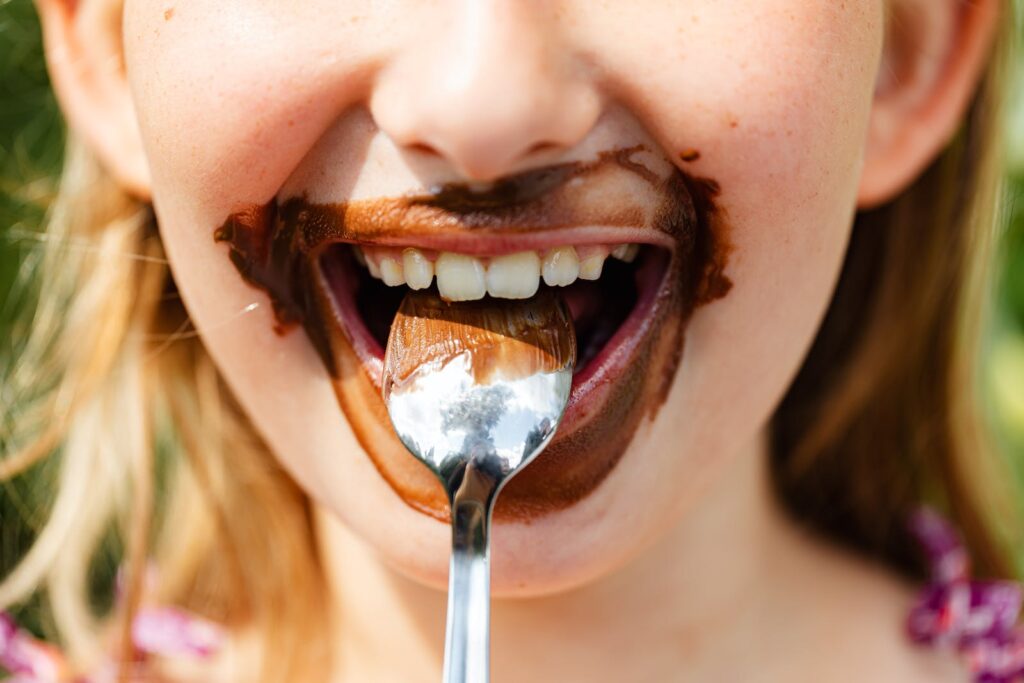What is Plaque? Symptoms, Causes & Treatments
When you rub your teeth with your tongue after you’ve eaten, your teeth can sometimes feel a little uneven. Sticky, even. This is dental plaque, that forms on our teeth during the day. It’s quite normal, but it’s important to clean it. What is plaque exactly, and how can you get rid of it?
In This Article:
- What is plaque
- Symptoms of plaque
- Causes of dental plaque
- Why is plaque a problem?
- Prevention and treatment
What is plaque
Dental plaque is a term you may have heard in toothpaste commercials. But what is plaque exactly? In short, it’s bacteria.
Or rather, it’s a sticky film of bacteria that constantly forms on your teeth. This biofilm is colorless or pale yellow. It’s composed of microorganisms, primarily bacteria, and water. It’s a normal part of our oral ecosystem, but when not properly managed, it can lead to various oral health issues.
Plaque forms every day. When we eat, especially foods rich in sugars and carbohydrates, we feed the bacteria in our mouth. When they feed on these food particles, they also break them down into a sticky, acidic film: dental plaque. This biofilm attaches to tooth surfaces and restorations. It can even stick to prosthetic appliances. Our saliva helps this, it acts almost like glue.
Technically, plaque is colorless, but it can cause tooth discoloration when food particles stick to it. If you’ve ever run your tongue over your teeth and felt like they’re not quite smooth, you’re feeling plaque.
This plaque, also called biofilm, comes in two varieties.
- Supragingival biofilm
This is a type of dental plaque that forms on the part of the tooth that’s above the gum line. It usually appears first after brushing. It’s mostly found between the teeth, in the small pits and grooves of the teeth, and along the gum line. This biofilm is primarily made up of aerobic bacteria, which need oxygen to survive. If the plaque isn’t removed quickly, a different type of bacteria that doesn’t need oxygen, called anaerobic bacteria, begins to grow. - Subgingival biofilm
Subgingival biofilm is plaque that forms under the gums. It happens when the bacteria from the supragingival biofilm move from above the gums to below. This plaque is mostly made up of anaerobic bacteria, which can survive without oxygen. Because this plaque is in a pocket under the gums, it’s not exposed to oxygen and can thrive if not removed.

Symptoms of plaque
Plaque is a soft, sticky substance that collects on, around, and between teeth. It’s often hard to see because it’s light-colored, like teeth.
Common symptoms of plaque include a fuzzy feeling on your teeth and persistent bad breath. Your gums can eventually also become red, swollen, and bleed after brushing.
You can see how much plaque you have with a simple test. Chew a special tablet that contains a dye. This dye stains the plaque, making it visible. After chewing the tablet, rinse your mouth with water and examine your teeth. Any red-stained areas indicate the presence of plaque. Often, it’s quite a lot! These tablets can help you brush better, as they show parts of the mouth you’ve missed or that need more attention.
Causes of dental plaque
When we consume foods, the bacteria in our mouths feed on these particles. As they break down the food, they produce acids, which combine with the bacteria and saliva to form a sticky, acidic film. That’s dental plaque.
Several factors contribute to plaque buildup. One of the primary culprits is the frequent consumption of sugary or starchy foods and drinks. But fruit can also cause plaque. These foods and drinks provide nutrition for the bacteria in our mouth, leading to increased acid production and, consequently, more plaque.
Poor oral hygiene is another significant factor. Regular brushing and flossing help remove plaque. That’s necessary, so it won’t turn into tartar. If plaque isn’t regularly removed, it can accumulate minerals from your saliva and harden into tartar. This is much harder to remove.
Lifestyle habits such as smoking and vaping can also contribute to plaque buildup. These substances can cause it to darken, making it more noticeable.
In summary, plaque can be caused by:
- Sugary and starchy food and drinks
- Smoking
- Bad oral hygiene
Why is plaque a problem?
In itself, plaque is harmless. But it does require good oral health, otherwise it can lead to problems.
Changes in the environment of your mouth can disrupt the balance of bacteria. The bacteria that can best adapt to these changes, survive. This sometimes leads to the growth of harmful bacteria, which can cause tooth decay and gum disease. Certain bacteria cause tooth decay in acidic environments, while others cause gum disease in slightly alkaline environments.
Tooth decay
Plaque is a significant concern for your dental health, if it’s not dealt with properly. The acids in the biofilm can erode tooth enamel. This can cause tooth decay and cavities.
Tartar
If plaque isn’t removed regularly, it hardens into tartar. Tartar is more resilient than plaque and requires professional dental cleaning for removal.
Gum disease
Plaque and tartar can lead to gum disease, starting with gingivitis and potentially progressing to more severe forms. Advanced stages of gum disease can eventually even lead to tooth loss.
Bad breath and infections
The bacteria in plaque can cause bad breath and tooth discoloration. In severe cases, tooth decay can lead to painful tooth infections. These infections can spread, leading to serious health complications.
High blood pressure
Some studies have found a link between certain oral bacteria and high blood pressure. So, maintaining a healthy balance of bacteria in your mouth is not just important for your oral health, but for your overall health as well.

Prevention and treatment
Preventing plaque buildup is largely a matter of good oral hygiene. Brushing your teeth at least twice a day, flossing daily, and using mouthwash can help remove food particles and bacteria that are the primary cause of plaque. A balanced diet and limiting the intake of sugary foods and drinks also contribute to plaque prevention.
Professional treatments for plaque include regular dental cleanings by a dental hygienist. These professionals use specialized tools to remove plaque and tartar, particularly in areas that are hard to reach through daily brushing and flossing. In some cases, dentists may recommend additional treatments, like fluoride treatments or dental sealants to protect your teeth and slow the growth of plaque-causing bacteria.
As we mentioned, dental plaque can also form on restorations, dentures, and bridges.
Regular dental check-ups are important for your oral health. These check-ups allow your dentist to detect any potential oral health issues early, including the buildup of plaque. Early detection and treatment of such issues can prevent them from becoming more serious problems.
